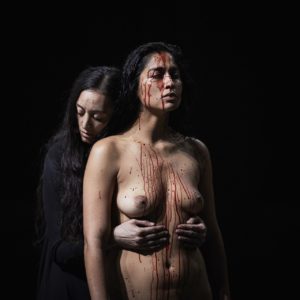Avignon: Standing in Time Symphonies of Pain part 2

Standing in Time. texts by Rasha Abbas. Direction, scenography by Lemi Ponifasio; sound design by Lemi Ponifasio (Auckland)
Lemi Ponifasio’s Standing in Time, also the example of a symphony of pain, speaks as well of abused women, the victims of history and colonial genocide. Ponifasio’s context is very different from that of Munyaneza’s because she meditates on the history of colonial oppression in New Zealand. The style of the production is highly informed by the performative culture of everyday rituals, religious ceremonies, celebrations and mourning as practiced by the mauri women from the New Zealand islands.
The play features an empty stage where raw fluorescent lamps aim directly at the audience. On the far right we see a chorus of women dressed in black and seated on a bench. On the far left, there is one single singer who leads the chorus. Between them, they have placed a pile of rocks, the central focus of this minimalist staging. What follows is a theatrical re-imagining of a murder, a burial and a morning ritual, where the world is at war. People fight either with each other or with the universe. There is always a victim, it is a woman, and there is no justice. no hope, only despair and death.
However, Lemi Ponifasio is not a story-teller. His directorial language is that of a metaphor focussing on a human being left alone to fight and to make peace with the universe. The play is a philosophical meditation on violence, on the fate of native women, who have disappeared from New Zealand’s urban landscapes. He believes that through their voices and the power of the theatre performance, their dignity and pride will be restored. Based on Ponifasio and his company’s extensive research into the rituals and cultural traditions of New Zealand and the Chilean people, Standing in Time also alludes to allegorical figures such as Angelus Novus and Hine Nui Te Po, as an attempt to overcome cultural stereotypes and allow us to open the way to the universals of human suffering so we share our empathy to the pain of others.
Singing, dancing, and the underlying electronic soundscape are the main devices of this performative ceremony. Constructed on the contrapuntal principles of juxtaposing singing of the chorus to solo recitals, the play crosses the boundaries of contemporary dance, choral work, ritual and theatre.
Although he rejects the narrative structures of story-telling, Ponifasio provides us with enough visual clues to follow the action. The stones, the dust, the tombs, the fluorescent light signify the presence of death, the moving and singing bodies stand for life, one of them turning into a victim, another into the goddess – Hine Nui Te Po. The turning point in this performance-ceremony is murder; its last image is a dead woman giving birth to the universe.
As singers carry stones to construct the border between the space of life and that of death, one performer crosses the space and stands naked under the fluorescent lamps as blood streams over her body. Such is the ritual of death: the naked female body turning into stone as the raging crowds become merciless killers. What follows is the ritual of burial performed by women and for women, as there is no male performer on stage.
As much as we would like this production to be a political statement, it remains Ponifasio’s poetic and philosophical exploration of the potentials of the theatrical empty space, his rejection of reducing theatre to the representation of the world’s social troubles, serving as a mirror to our calamities. Standing in Time is Ponifasio’s manifesto, his attempt to render our lives within the realms of cosmology not politics. The space, the choral work, the movement of bodies, the diagonals and the circles created by the chorus, the shrieks and the heavy breathing become these performers’ vital devices of communication with each other and with the world. Watching Ponifasio’s work demands concentration and empathy. We are expected to let go of our intellect and follow our instincts, to experience the sound and the visual structures of this performance as if it were pure movement or music. Perhaps, if we learn how to let go, we will also learn how to come together.
With Gabriela Arancibia, Rosie Te Rauawhea Belvie, Kasina Campbell, Te Riina Kapea, Hinerauwhiri Huia Ohomairangi Paki, Ria Te Uira Paki, Kahumako Rameka, Manuao Ross
July 7 – 10 , 2017
COUR DU LYCÉE SAINT-JOSEPH